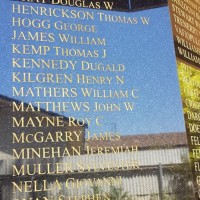Thomas William HENRICKSON
Age at Death32yrs 7 mths
Date Of Death26 January 1910 : Reg Black Range 2/1910
Place Of BirthBundaberg, Queensland
OccupationMiner
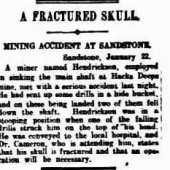
West Australian, Monday 24 January 1910, page 4
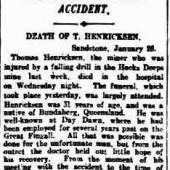
West Australian, Saturday 29 January 1910, page 11
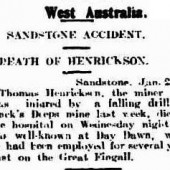
Geraldton Guardian, Saturday 29 January 1910, page 3
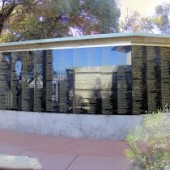
Eastern Goldfields Miners Memorial at the WA Museum, Kalgoorlie WA - Photo Paul Doust
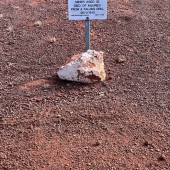
Black Range Cemetery - Plaque by outback Graves - Photo Find a Grave
Name Of Mine On Which Last Employed
Hacks Deeps GM, also known as Black Range GM, Sandstone, Western Australia
Diagnosis or cause of accident
At the Black Range West Gold Mine, some drills were being lowered in a hide bucket down the shaft, when one of them dropped through the bucket, down the shaft and struck a man working below, inflicting injuries to his head from which he died four days later. The pent house had been partly opened to facilitate passing the dirt. It is pretty clear that there was much carelessness in this case on someone's part in using an old and broken bucket for such a purpose, but it was impossible to bring home negligence to any particular person
- Dept of Mines Report 1910
Place Of Burial
Sandstone Cemetery, Western Australia
Submitted by
Eric Chamberlain - Volunteer
MSW
Single
District
Sandstone
Cause of Death
Mine Accidents
Father
JacobHENRICKSON
Mother
Marie KNUDSEN
Other Information
Came from Bundaberg, Queensland.
Electoral Roll: Name: Thomas William Henricksen
Gender: Male
Electoral Year: 1903
Subdistrict: Menzies
State: Western Australia
District: Coolgardie
Country: Australia
Sandstone - Old gold mining town now a virtual ghost town.
Located 157 km east of Mount Magnet and 661 km north of Perth, Sandstone is a town which started life as a boom goldrush town in the late 1890s and had become a virtual ghost town by the end of World War 1. Consequently the history of the town is very much the history of the East Murchison - the discovery of gold, the sudden influx of miners, the dreams of a town that would last forever, the sudden decline in the goldfields, the disappearance of the population, and the town settling down to become a small centre for the surrounding pastoral leases.
The first European into the area was John Forrest who, in 1869, led an expedition through the East Murchison in search of the remains of Ludwig Leichhardt.
The Western Australian goldrushes of the 1880s led to the opening up of the Murchison. In 1894 a prospector, Ernest Shillington, discovered gold about 20 km south of the present site of Sandstone and in 1903 (very late in the history of the region) George Dent and two brothers from the Hack family found gold only a few hundred metres from the present townsite. If you turn south at Griffith Street (which becomes Paynes Find Road) you will see the remains of the mine on your left.
Between 1903 and 1916 over 700 tons of ore were extracted.
A few days after the discovery of the Hacks Reef Black Range Mine a prospector named Tom Payne (after whom Paynes Find is named) found gold at Oroya. Payne sold the mine to the Oroya Black Range Company Ltd and it was worked until 1914 during which time it yielded about 364 000 ounces of gold. The site of the mine can be visited by continuing through Sandstone heading west on Agnew Road. In 1932 a miner was trapped in the disused shafts and, when the walls became unstable, rescuers were forced to abandon attempts to save him. He is remembered on a nearby plaque. [See Samuel URE]
From 1903 onwards more reefs of gold were discovered to the north of the present town so that in September 1906 the town was officially gazetted. Looking at the tiny town today it is hard to imagine that between 1906-12 a floating population of between 6000¬8000 lived here and that the town¹s services included four hotels, two banks, a railway line, a brewery (the remains lie beyond the Oroya Gold Mine - turn south) and a State run gold battery. - which was dismantled in Paynesville and pulled to Sandstone by teams of bullocks and donkeys in 1904. The battery only closed down in 1982 and can still be seen off Menzies Road (which runs southwest from Paynes Find Road).
The town's decline coincided with the outbreak of war in Europe. Many of the miners went off to serve overseas and never returned. Others, seeing the declining fortunes of the mines, slowly drifted away from the area. By 1919 the population had dwindled to a mere 200 people. The town continued to be home to resilient prospectors but it became a service centre for the surrounding large pastoral holdings.
The town was the inspiration for the mining town in Randolph Stow's novel Tourmaline which Stow described as 'rust-red roofs, the skeletal obelisks of headless windmills...It is not a ghost town. It simply lies in a coma. This may never end.
The Sandstone Heritage Trail, which may still be available at the Shire offices, is an excellent guide to the town and the surrounding area.
The Hack brothers discovered gold here in 1903, just south of what was to become the Sandstone townsite. The mine is just outside the town boundary and immediately east of the Sandstone-Paynes Find Road. It is marked by two large groupings of remnant battery sands.
Several reefs run east-west between here and the Oroya Mine on the east side of town. Between are countless scattered shafts.
The mine was sold to Hans Irvine, and the Black Range Gold Mining Company was formed to develop it. In January 1910, Thomas Hendricksen died in the underground workings when a drill fell on his head. Two months earlier the Inspector of Mines had brought charges against the company when a rope broke seriously injuring a miner named Lane (surname). The case was dismissed, being the normal attitude towards safety of the day.
This led a local paper to launch some scathing attacks on the mine, stating the mining practices were unsafe, leaving tonnes of rock hanging precariously over the miners heads in the underground workings. It further claimed the Inspector of Mines was directed to inspect only safe areas of the mine, and the men were working in conditions with poor ventilation, and dampness. A local term became known at the time that men from the mine suffered 'Hack's Cough'. This led to a Royal Commission on the mine in mid 1910, but it appears little came of it.
Between December 1905 to September 1916 the mine produced 269 073 tonnes of ore for 185 986 ounces of gold at 8 dwt. From June 1905 to March 1916, 192 940 tonnes of ore was cyanide for 427 880 ounces 5 dwt. July 1911 to September 1916, 73 301 tonnes of slimes were treated for 63 775 tonnes of concentrates yielding 2680 ounces at 13 dwt. Between 1905 to 1914 the mine gave shareholders 243 718 pounds in dividends.
In 1917, Charlie Blackmore, L.J. Meatchem, and Pigdon were operating at the north end of the old Black Range Co lease on GML 844B. Meatchem had been underground manager at the mine for seven years during the Black Range Co days. It was still active in 1919, but under whose name is unclear. The mining machinery was said to be inadequate, but a lode against a Hanging Wall had been discovered in Nancy's Reward lease, at the west end of the old group of leases.
A further two finds around the old Hack's leases were made in 1923 by prospectors Pascov and Mijat, and Funnell, Hyman, and Resenius (surnames).
In 1936, the De Bernales Group, under subsidiary Atlas Gold Mines Ltd acquired the mine. De Bernales had taken advantage of the gold boom in the 1930's, by raising capital in London, to purchase many mines in Western Australia. Few came into production, and the operation had more to do with financing a lavish lifestyle for De Bernales and his cronies. Hack's was a rare exception. Forty men were employed and some crushing's were produced across 1939-1940.

